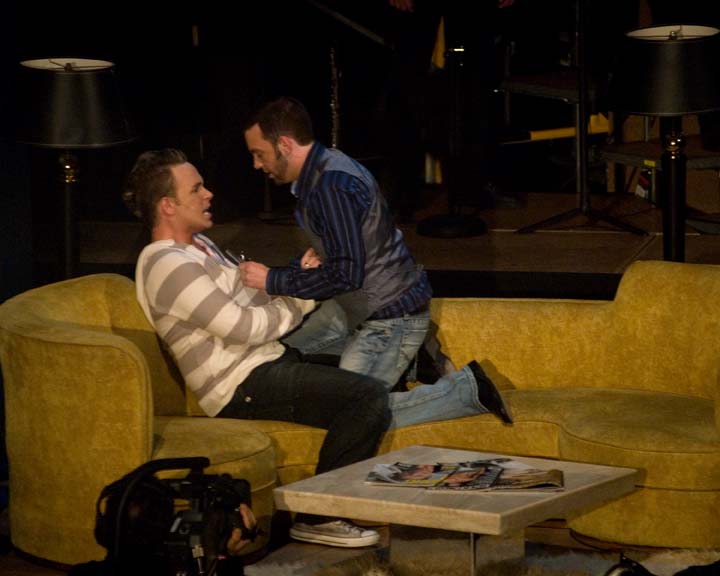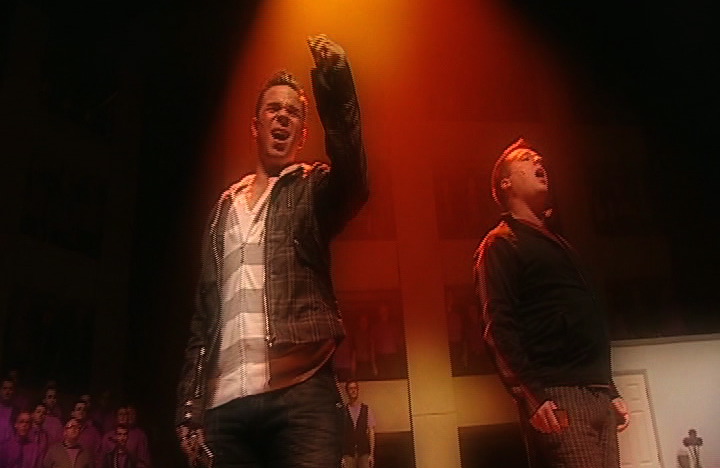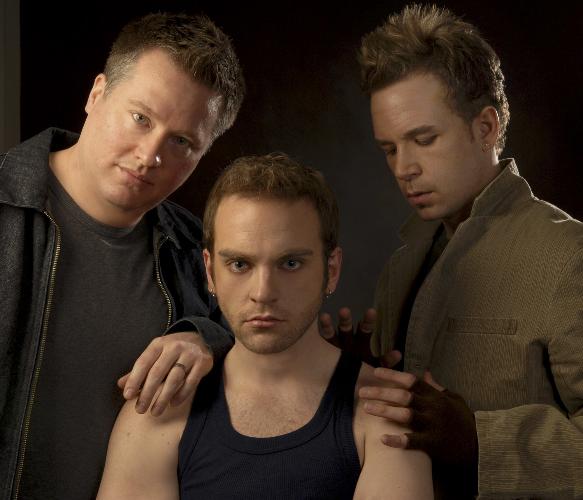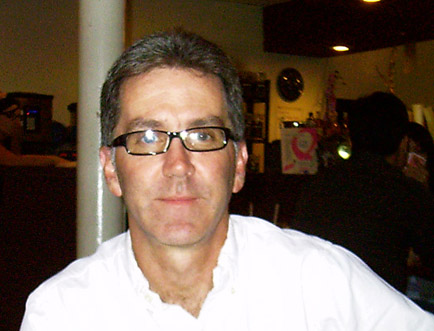FILM: Making Movies That Matter
"Butter City" producer Myron Berdahl chats with MN documentary filmmaker Emily Goldberg about her newest production, "TCGMC: Reflections on Meth Addiction," which will have its broadcast premiere on TPT June 21 at 8 pm.






MINNEAPOLIS FILMMAKER EMILY GOLDBERG SEEKS OUT projects that speak to our shared humanity. Her hope is that by moving, or even surprising viewers with the stories in her films audiences will, at the very least, question their preconceptions. A former clarinet player herself, Goldberg has always been drawn to the music scene. In fact, much of her documentary work over the past 25 years has been focused around stories of musicians and issues important to the local scene. In 1988, she produced and directed The Minneapolis Sound, a first-person narrative documentary featuring Prince, The Time, The Replacements, Husker Du, The Jets, and others. Then, in 1990 she produced and directed Peter Himmelman: A Million Sides, an intimate doc tracing the voyage of self-discovery of a Jewish musician from St. Louis Park. In 1991, she filmed KMOJ: Heart and Soul, which chronicled a day in the life of the Twin Cities’ only African-American radio station. Each of these documentaries was broadcast on Twin Cities Public Television and garnered awards. (In order to win an award in public television,” jokes Goldberg, “it helps if your title has a colon in it.”)
TCGMC: Reflections on Meth Addiction, her latest production, features live footage from the Twin Cities Gay Mens Chorus (TCGMC) stage production of Through A Glass, Darkly, which addresses the dangers of meth addiction in the gay community. The show, framed as a rock opera, is upbeat and high-energy, as is much of Goldberg’s footage. Given the seriousness of meth addiction, it’s a bold choice to marry such a dark subject with what could be perceived as light-handed treatment.
In fact, the musicals composer, Michael Shaieb from New York, originally had much the same off-the-cuff response to the idea of staging such grave subject matter this way. My initial reaction was, well, this is a pretty dumb idea, says Shaieb. But over the course of developing the production, he has changed his tune. His poignant score commands attention, drawing the audience into the storyline and adding an emotional investment to the underlying message that meth is nothing to be tampered with, its a killer.
The fact that some of the cast members are actually in recovery adds to the power of the story. Paul Brekke, TCGMC tenor started doing meth at 16, and he remembers simply, “It was easy to get. TCGMC Artistic Director Dr. Stan Hill agrees that meth is close to home for everyone, explaining, Youve heard of the six degrees of separation? Well, I think with meth addiction, its down to two degrees.”
The three-day taping session for Goldberg’s program- a video chronicle of actual performance footage augmented by interviews with cast and crew was all shot at the Ted Mann Theater during the production’s actual run. We set up a control room behind the stage and had a full crew, including four cameras, set up for the shoot,” says Goldberg.
The panning camera movement and the lighting and graphic effects which run throughout Goldbergs production result in a short film that is substantial and satisfying to watch more like a narrative film than you’d expect from a simply rendered account of a stage production.
The performances by TCGMC tenor and recovering addict Paul Brekke, Bryan Fisher, and especially Justin Scharr, are outstanding. Brekke plays a conniving veteran tweaker (methamphetamine addict), who will do anything for his next fix. Fisher is his jilted boyfrienda person who, though not an addict himself, is a casualty of substance abuse all the same. Scharr’s role is a novice user tempted into the scene equally by the allure of meth and the urgings of his new drug-using friend. The conflict practically writes itself, but the story might fall prey to cliché without the authentic emotional pang delivered by these performers.
Goldberg’s clever visual framing also helps: the majority of the chorus stands backstage, their faces framed by window-like openings which leave the impression that they are voyeurs looking into a dark and hidden world. They are us, society-at-large, watching and struggling to deal with a problem we don’t understand. Indeed, the main performers have nowhere to hidewith the audience in front of them and the chorus behind, their “secret” meth addiction is anything but.
The broadcast premiere of TCGMC: Reflections on Meth Addiction is scheduled to air for the first time June 21 on Twin Cities Public Television. In honor of the occasion, filmmaker Emily Goldberg met with me at the Second Moon Café to discuss her path so farfrom her New York childhood to a flirtation with archaeology in college, and, finally, to the name she’s made for herself as a Minnesota documentarian.
Lets start from the beginning.
Well, I was born in Chicago and moved to New York at the age of two. My father was an English professor; 18th-century novels were his specialty – Henry Fielding, Jane Austen. So, we were weaned on grammar at the dinner table. I attended Oberlin College, where I studied art history then, later, I was drawn specifically to archaeology. My first archaeological work experience after college was in Tuscany, where I was part of an excavation crew. It couldnt have been more alluring. We were finding all kinds of artifacts, including tiny ivory sphinxes which were 2500 years old. And, then I got this job in the basement at the University of South Carolinacleaning and sandblasting artifactsand all the sexiness of the job went out the door.
So, how did you get involved with filmmaking?
In 1982 I applied for an internship at TPT. I was looking at Minnesota, New York, Chicago, and Boston for potential employment. When I came to Minnesota to check it out, I was sitting in a sauna after a workout at the YWCA. There was some woman next to me, visiting from Boston, and she told me that Minneapolis is a great place to get your feet on the ground, a fabulous city. She sort of talked me into it. I really didn’t have much experience with Minnesota before I took that job. My parents knew a couple here in Minnesotathe husband was an eye surgeon. So, as a child, every time we would come here I would get a free eye exam. So my early memories of Minnesota are, literally, blurry ones. Then, I met a Minnesotan at college who used to get teased, with people asking her, Do you have outdoor plumbing?” Most of them were from the east coast and had no connection to Minnesotatheir question was serious. So, my associations for Minnesota, before I moved here, were blurry city lights and that maybe you used outhouses here.
And, did you find outhouses here? [laughing]
No, but I do remember clearly that the snow was up to my hips when I arrived, and that I was thinking to myself: This is the frontiernow, I am a pioneer.
When you applied for the TPT internship, you were bringing your art history and archaeology education with you?
Yeah, for whatever that was worth. When I was in college in the late ’70s, there just werent video programs. (Or, at least I wasnt aware of them.) It was the Jurassic era. [she laughs] Most of my peers at TPT had backgrounds in history or English or something unrelated to media, too. That was comforting to me, because it meant, at the time, that it wasnt about knowing television. It was about using your critical thinking skills and learning how to craft a story. My first job at TPT was interning on Newtons Apple, a show I worked on for about five years. I was fortunate to start in as a production assistant on a show of that quality. It helped me to move into the producer role more quickly than I may have through a different avenue. Sometimes its all about being in the right place at the right time.
How long were you at TPT?
I was at TPT from 1982 1997, except for my busmans holiday from 95 96, when I was doing public broadcasting work out in Portland, Oregon. What I love about television, film, and video work is that it is a collaborative efforta combining of each individual’s talents. Then, after leaving TPT, I self-produced a documentary about a transgender singer in a Minneapolis glam rock band and h(is)/(er) wife negotiating the frontiers of love and gender (Venus of Mars). There was a point after more than a year of editing that I couldnt see straight and wanted to bring another person in, but that person just wasnt available.
One of the downsides of self-producing and self-funding?
Yesso, on my next project, which looks at both the activist and governmental sides of eco-terrorism, I am working with co-director and producer, Matt Ehling, who will be that second set of eyes I’ve always been looking for. Hopefully, this will help to alleviate the problem of temporary blindness, which can take hold when you get too close to your subject all on your own. When I was doing Venus of Mars, I would invite people over to my house to watch the footagesome in the business and some not. I would ask them what worked for them, and what they didn’t like. For me, putting together a good film requires a delicate balance between telling the story that you think you know is in the footage, and also letting go and having someone else like a dedicated editor do that too.
You’ve mentioned that your next project on eco-terrorism was prompted by an email you received. The subject line of this email read: My friend Jonathan is not an eco-terrorist.” What did “Jonathan” do?
Jonathon is a radical, animal rights activist. In this case, he was involved in arson at a horse slaughterhouse; we met him while he was awaiting sentencing, and he is now in prison. For this documentary, we are looking at the broader issues involved with activism: How far should one go for what they believe in? And, how far should the government go in trying to contain this activity? We are not taking sidesit’s a very complex subject, and theres lots of grey area. Its kind of like the film Capturing the Friedmans, where everyone that speaks, from both sides, seems to make sense, or even seems to be in the rightbut they cant all be.
What exactly is eco-terrorism? And, what was Jonathan trying to accomplish by burning down the horse slaughterhouse?
The slaughterhouse was run by a Belgian company which was shipping horse meat to Europe for consumption. Jonathans desire was to prevent any unnecessary suffering of animals, and, apparently, this place was not killing the horses humanely. Another interesting question that arises out of this is what is “terrorism?” Specifically, when is something a garden-variety criminal act, and when does it rise to the level of terrorism?
I know the premiere of your new film, TCGMC: Reflections on Meth Addiction, is coming up June 21, but have you shown the edited footage to anyone else yet?
We just showed the completed production to TCGMC Artistic Director Stan Hill. Throughout the whole thing, he was scratching these loud notes with his pencil. I thought, Oh no, were going to have to re-edit this whole thing! When the lights came up, and I asked him what he thought, though, he put my worries at ease. It turned out that his notes were all about the things he really liked, with very little criticism.
What: TCGMC: Reflections on Meth Addiction will have its broadcast premiere on TPT channel 17
When: Saturday, June 21st at 8:00 pm.
About the filmmaker: Emily Goldbergs documentaries explore the human condition by intimately chronicling the lives of artists, activists, gender outlaws, and others. She is a 2007 McKnight Artist Fellow whose Emmy Award-winning work has been broadcast on PBS, TLC, and RAI (Italy), and screened in numerous film festivals around the world, from the International Documentary Festival in Amsterdam to the Museum of Modern Art.
About the writer: Myron Berdahl is an independent filmmaker and producer of the cable access show Butter City, which features clips from regionally produced film/video work as well as interviews and discussion with local filmmakers.